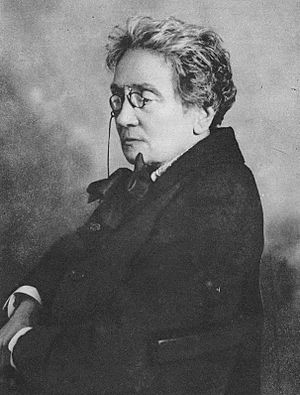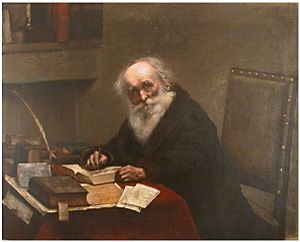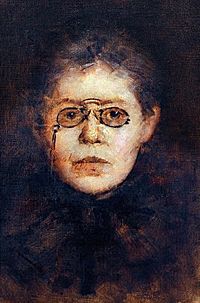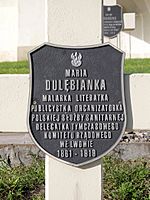Maria Dulębianka facts for kids
Quick facts for kids
Maria Dulębianka
|
|
|---|---|
 |
|
| Born | 21 October 1861 Kraków, Grand Duchy of Kraków, Austrian Empire
|
| Died | 7 March 1919 (aged 57) |
| Nationality | Polish |
| Other names | Maria Dulembianka |
| Occupation | artist, activist |
| Years active | 1881–1919 |
Maria Dulębianka (born October 21, 1861 – died March 7, 1919) was a Polish artist and a strong supporter of women's rights. She worked hard to help women get the right to vote and to attend universities.
Maria studied art in big cities like Warsaw, Vienna, and Paris. Two of her paintings won special awards at a famous art show in Paris in 1900. She often painted portraits of her close friend, the poet Maria Konopnicka. In 1908, Maria Dulębianka tried to run for a seat in the Galician Parliament. However, she was not allowed to because women were not permitted to be members. When women in Poland finally gained the right to vote in 1918, Maria Dulębianka became a representative for the new government. She passed away from typhus, a sickness she caught while helping prisoners during the Polish–Ukrainian War in 1919.
Contents
Early Life and Art Studies
Maria Dulębianka was born in Kraków, which was part of the Austrian Empire at the time. Her birthday was October 21, 1861. Her parents were Maria and Henryk Dulęba. Her family owned land and were part of the gentry, which was a class of people with high social standing.
Maria went to a special school in Kraków and also took private art lessons from a famous painter named Jan Matejko. She wanted to study art at the Kraków Academy of Fine Arts, but she couldn't get in because she was a girl. At that time, women were not allowed to attend. So, Maria went to the Vienna School of Arts and Crafts to continue her studies.
After two years in Vienna, she moved to Warsaw to learn from another artist, Wojciech Gerson. In 1884, she traveled to Paris to study at the Académie Julian. She learned from several well-known artists there until 1886. Most of Maria Dulębianka's paintings showed portraits of people or scenes with women and children. She started showing her art in Kraków, then in Warsaw, and later in Paris.
Maria Dulębianka's Career
Becoming a Painter
In 1887, Maria Dulębianka returned to Warsaw. She wanted to open an art school especially for women. She strongly believed that women should be allowed to study art at places like the Kraków Academy of Fine Arts.
In 1889, she met Maria Konopnicka, a writer who had eight children. Maria Konopnicka was living on her own, separate from her husband. Dulębianka was nearly 30 years old, and Konopnicka was 19 years older. They became very close friends and spent a lot of time together. From then on, Konopnicka became the main person Maria Dulębianka painted.
Konopnicka had a big influence on Dulębianka. Maria Dulębianka became more and more involved in helping others and fighting for women's rights. In 1890, the two friends started traveling a lot. They visited Germany, Italy, France, and other places, rarely returning to Poland. They often traveled by bicycle. Maria Dulębianka was known for her unique style of dress. She often wore trousers or long, straight skirts, shirts with cuffs and ties, a long coat, and flat shoes. She also kept her hair short and wore a monocle or pince-nez glasses.
Wherever they lived, Konopnicka made sure Maria Dulębianka had a studio so she could keep painting. Dulębianka showed her artwork in many cities, including Dresden, Kiev, London, Lviv, Munich, Paris, and Prague. In 1900, at the big Paris Exposition, two of her paintings, Na pokucie (On Penance) and Sieroca dola (The Orphan's Fate), received special honors. Another painting, Studium dziewczyny (Girls' Studio), was bought by the National Museum in Kraków while it was still on display.
Working for Women's Rights
In 1897, Maria Dulębianka joined a group in Lviv that worked for women's freedom. She successfully pushed the city to open a high school for girls, which helped more girls get a good education. She wrote articles about women's issues for a magazine called Ster (The Rudder). She also worked as an editor for other newspapers like Głos Kobiet (Women's Voice) and the Kurier Lwowski (Lviv Courier).
In 1901, Maria Dulębianka gave a speech in Zakopane called Dlaczego ruch kobiecy rozwija się tak powoli? (Why is the Women's Movement Developing so Slowly?). The next year, she talked about women's art. In 1903, she published an article called O twórczości kobiet (About Women's Creativity).
In 1902, Maria Konopnicka was celebrated for her 25 years as a writer. As a special honor, she was given a home in Żarnowiec. From 1903, she and Dulębianka spent their springs and summers there, but they continued to travel during the rest of the year.
Maria Dulębianka started campaigning for women to get the right to vote in Galicia in 1907. She spoke at the Warsaw Philharmonic, explaining that women had no real political power. The next year, she ran as a candidate for the Agrarian Party in the Galician Parliament elections. She gave speeches about equality. She also wrote a booklet called Polityczne stanowisko kobiety (Woman's Political Stance). Even though 511 men voted for her, her name was removed from the voting list. This was because women were not allowed to serve in Parliament, so the votes for her did not count.
In 1909, Dulębianka spoke for another political group, asking for equal rights for everyone, Polish independence, and cooperation between Poles and Ukrainians. When Konopnicka's health got worse in 1910, they moved permanently to Lviv. Maria Konopnicka, Dulębianka's friend for two decades, died on October 8, 1910. Dulębianka organized her funeral, which was attended by thousands of people.
In 1911, Maria Dulębianka started the Women's Electoral Committee to push for women to be included in the Lviv City Council. She also spoke out about the Russian Empire taking over the Chełmszczyzna region.
Maria Dulębianka continued her work to help the poor and gain rights. She founded several organizations, including the Związek Uprawnienia Kobiet (Union of Women's Rights), the Liga Mężczyzn dla Obrony Praw Kobiet (Men's League for the Defense of Women's Rights), and the Komitet Obywatelskiej Pracy Kobiet (Women's Civic Work Committee). Through the Civic Work Committee, she set up kitchens for people in need, nurseries for children, and a club for street children and orphans.
When the Rifle Association was formed in Lviv, Maria Dulębianka became one of its first members, which was unusual for a woman at the time. In 1914, she encouraged members of the Civic Work Committee to support Piłsudski's Legions when Lviv was taken over by the Russian Army. She and her committee helped soldiers and regular people while the city was under Russian control.
In 1918, Poland became an independent country again, and women finally gained the right to vote. Maria Dulębianka became a representative for the Provisional Government Committee and was chosen to lead the Women's League. When the Polish–Ukrainian War started in November, she joined the Polish Red Cross. She helped organize medical services and took part in defending Lviv. She worked as a nurse at first, but then became a messenger. She organized help for Polish soldiers who were held in Ukrainian prisoner-of-war camps. Maria Dulębianka traveled through snow, sometimes by train, sometimes on foot or horseback, to reach a camp at Mikulińce. There, she caught typhus. She and her group returned to Lviv.
Death and Lasting Impact
Maria Dulębianka died on March 7, 1919, in Lviv. She was first buried in Maria Konopnicka's tomb in Lychakiv Cemetery. Her funeral was a big event, attended by many people who supported women's rights, single mothers, and people from the shelters she had helped. Later, Maria Dulębianka's remains were moved to her own separate grave.
For a long time, Maria Dulębianka, like many women activists, was not often mentioned in history books. But with the rise of feminism in the 1990s, her work became more recognized. She is remembered for her important efforts in women's rights, for helping women get into the Academy of Fine Arts, and for starting the first high school for girls in Lviv. Her historic campaign in 1908 is seen as a very important moment in the fight for women's right to vote in Poland. In 2018, a film called Siłaczki was released. It showed the struggle of Polish women to gain equal rights, and Maria Dulębianka was played by Maria Seweryn.
|




